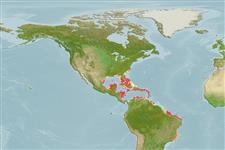Common names from other countries
Environment: milieu / climate zone / depth range / distribution range
Ecologia
marino associati a barriera corallina; distribuzione batimetrica 3 - 30 m (Ref. 9710). Tropical
Western Atlantic: southeastern Florida, USA and Bahamas to Brazil.
Size / Peso / Age
Maturity: Lm ? range ? - ? cm
Max length : 15.0 cm TL maschio/sesso non determinato; (Ref. 26340)
Spine dorsali (totale) : 5; Raggi dorsali molli (totale) : 8 - 9; Spine anali: 3; Raggi anali molli: 32 - 34. Ventral profile deeply curved in front of anal fin, tapering upward to slender caudal peduncle. Mouth very oblique (Ref. 26938). Scales ctenoid along the back posterior to dorsal fin and ventrally on head and body, otherwise cycloid, coppery with a dark band at base of anal fin; young nearly transparent, silvery over abdomen (Ref. 13442).
Occurs in clear water with coral bottom. Form aggregations in dark crevices and caves (Ref. 9710). Nocturnal (Ref. 9626). Its name probably refers to the juveniles, which are so transparent that the backbone can be seen in the living fish (Ref. 26938). Feeds on zooplankton, particularly the larval stages of invertebrates (Ref. 13442).
Life cycle and mating behavior
Maturities | Riproduzione | Spawnings | Egg(s) | Fecundities | Larve
Robins, C.R. and G.C. Ray, 1986. A field guide to Atlantic coast fishes of North America. Houghton Mifflin Company, Boston, U.S.A. 354 p. (Ref. 7251)
IUCN Red List Status (Ref. 130435)
CITES (Ref. 128078)
Not Evaluated
Threat to humans
Harmless
Human uses
Pesca: di potenziale interesse; Acquario: Potenziale
Strumenti
Special reports
Download XML
Fonti Internet
Estimates based on models
Preferred temperature (Ref.
115969): 25 - 28.1, mean 27.4 (based on 656 cells).
Phylogenetic diversity index (Ref.
82804): PD
50 = 0.5000 [Uniqueness, from 0.5 = low to 2.0 = high].
Bayesian length-weight: a=0.01413 (0.00715 - 0.02792), b=2.98 (2.80 - 3.16), in cm Total Length, based on LWR estimates for this species & Genus-body shape (Ref.
93245).
Trophic level (Ref.
69278): 3.1 ±0.0 se; based on diet studies.
Resilienza (Ref.
120179): Alto, tempo minimo di raddoppiamento della popolazione meno di 15 mesi (Preliminary K or Fecundity.).
Fishing Vulnerability (Ref.
59153): Low vulnerability (10 of 100).
